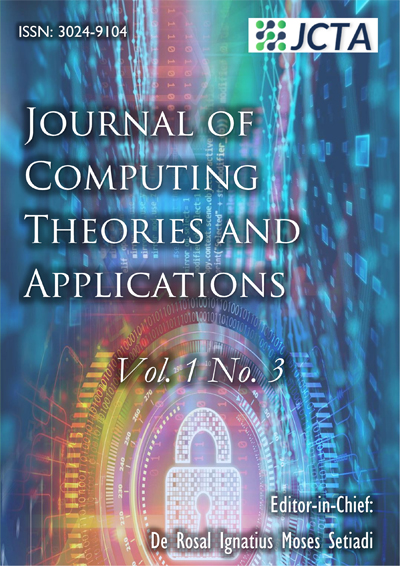IMANoBAS: An Improved Multi-Mode Alert Notification IoT-based Anti-Burglar Defense System
DOI:
https://doi.org/10.62411/jcta.9541Keywords:
Burglar systems, IMANoBAS, IoT, Notification Alerts, SecurityAbstract
Burglary involves forced or unauthorized entry, which leads to damage or loss of property having monetary or emotional value and, more severely, puts lives at risk. The dire need for the safety of lives and properties has attracted so much research on burglary alert system using Internet of Things (IoT) technology. Most of the research focused on alerting the users of burglary attempts using any or a combination of two notification methods: SMS, call, and email. This study emphasizes three-mode notification that combines SMS, call, and email using the application of IoT technology in a burglary alert system, which uses a Passive Infrared (PIR) sensor for burglar detection to ensure that Homeowners or authorized personnel get alerts in events of imminent attempt to break-ins. The study also details the sensor integration with its supporting components, such as the central hub or microcontroller, buzzer, LED, and network interface in the development of the system. The software was developed to facilitate seamless integration with the hardware, ensuring timely and accurate event detection and subsequent alert generation using Arduino IDE programming language, a framework based on the C++ language. The system effected the 3-mode notification to ensure that users get notification in case of an imminent break-in since the failure of the three modes simultaneously is extremely rare. The system’s performance based on its responsiveness on the 3-mode notifications was evaluated, and an average of 83.56% responsiveness was obtained, indicating an acceptable response time.References
I. J. Onyeacholem and E. U. Omede, “Authenticated and Dynamic Websites : A Sure Control against Website Authenticated and Dynamic Websites : A Sure Control against Website Spoofing Attacks,” J. Softw. Eng. Simul., vol. 9, no. 3(2023), pp. 57–60, 2023.
B. Kizilkaya, E. Ever, H. Y. Yatbaz, and A. Yazici, “An Effective Forest Fire Detection Framework Using Heterogeneous Wireless Multimedia Sensor Networks,” ACM Trans. Multimed. Comput. Commun. Appl., vol. 18, no. 2, pp. 1–21, May 2022, doi: 10.1145/3473037.
S. S, S. Yamuna, and S. N. George, “An IoT based Active Building Surveillance System using Raspberry Pi and NodeMCU,” Jan. 2020, [Online]. Available: http://arxiv.org/abs/2001.11340
R. Kumar and D. Kumar, “Hybrid Swarm Intelligence Energy Efficient Clustered Routing Algorithm for Wireless Sensor Networks,” J. Sensors, vol. 2016, pp. 1–19, 2016, doi: 10.1155/2016/5836913.
Saba, T., Rehman, A., Sadad, T., Kolivand, H., & Bahaj, S. A. (2022). Anomaly-based intrusion detection system for IoT networks through deep learning model. Computers and Electrical Engineering, 99, 107810.
M. Lei, L. Xu, T. Liu, S. Liu, and C. Sun, “Integration of Privacy Protection and Blockchain-Based Food Safety Traceability: Potential and Challenges,” Foods, vol. 11, no. 15, pp. 1–31, 2022, doi: 10.3390/foods11152262.
M. I. Akazue, A. A. Ojugo, R. E. Yoro, B. O. Malasowe, and O. Nwankwo, “Empirical evidence of phishing menace among undergraduate smartphone users in selected universities in Nigeria,” Indones. J. Electr. Eng. Comput. Sci., vol. 28, no. 3, pp. 1756–1765, Dec. 2022, doi: 10.11591/ijeecs.v28.i3.pp1756-1765.
A. J. Majumder and J. A. Izaguirre, "A Smart IoT Security System for Smart-Home Using Motion Detection and Facial Recognition," 2020 IEEE 44th Annual Computers, Software, and Applications Conference (COMPSAC), Madrid, Spain, 2020, pp. 1065-1071, doi: 10.1109/COMPSAC48688.2020.0-132.
D. Upadhyay and S. Sampalli, “SCADA (Supervisory Control and Data Acquisition) systems: Vulnerability assessment and security recommendations,” Comput. Secur., vol. 89, p. 101666, Feb. 2020, doi: 10.1016/j.cose.2019.101666.
A. Ometov et al., “A Survey on Wearable Technology: History, State-of-the-Art and Current Challenges,” Comput. Networks, vol. 193, p. 108074, Jul. 2021, doi: 10.1016/j.comnet.2021.108074.
C. Joshi, J. R. Aliaga, and D. R. Insua, “Insider Threat Modeling: An Adversarial Risk Analysis Approach,” IEEE Trans. Inf. Forensics Secur., vol. 16, pp. 1131–1142, 2021, doi: 10.1109/TIFS.2020.3029898.
K. Okokpujie, G.C. Kennedy, D. Ayankoya, E. Noma-Osaghae, I. P. Okokpujie and J.A Kalibbala, Development of a Real-Time Home Security and Safety Management System. In:nPattnaik, P.K, Sain. M., Al-Absi, A.A. (eds). Proceedings of 2nd International Conference on Smart Computing and Cyber Security. SMARTCYBER 2021. Lecture notes in Networks and Systems, vol 395, Springer, Singapore. https://doi.org/10.1007/978-981-16-9480-6_11
P. Joshi, A. Solomy, A. Suresh, K. Kachroo, and P. Deshmukh, “Smart Fuel Station,” SSRN Electron. J., 2020, doi: 10.2139/ssrn.3572319.
R. F. R. Suleiman and F. Q. M. I. Reza, “Gas station fuel storage tank monitoring system using internet of things,” Int. J. Adv. Trends Comput. Sci. Eng., vol. 8, no. 1.6 Special Issue, pp. 531–535, 2019, doi: 10.30534/ijatcse/2019/7881.62019.
A. Hurt, “Internet of Medical Things emerges.,” Dermatology Times, vol. 40, no. 10, pp. 52–58, 2019, [Online]. Available: http://ezproxy.uct.ac.za/login?url=https://search.ebscohost.com/login.aspx?direct=true&db=cin20&AN=138944526&site=ehost-live
A. A. Ojugo and O. Nwankwo, “Forging a Spectral-Clustering Multi-Agent Hybrid Deep Learning Model To Predict Rainfall Runoff In Nigeria,” Int. J. Innov. Sci. Eng. Technol., vol. 8, no. 3, pp. 140–147, 2021.
A.R. Abdul Rashid and F. Zakaria , “Design and Implementation of Home Security System Using Piezoelectric Sensor”. MJoSHT, Vol.5 no.1, Feb. 2020. DOI: 10.33102/MJOSHT.V5i1.129
K. Kakhi, R. Alizadehsani, H. M. D. Kabir, A. Khosravi, S. Nahavandi, and U. R. Acharya, “The internet of medical things and artificial intelligence: trends, challenges, and opportunities,” Biocybern. Biomed. Eng., vol. 42, no. 3, pp. 749–771, 2022, doi: 10.1016/j.bbe.2022.05.008.
O. D. Voke, M. I. Akazue, E. U. Omede, E. . Oboh, and A. Imianvan, “Survival Prediction of Cervical Cancer Patients using Genetic Algorithm-Based Data Value Metric and Recurrent Neural Network,” Int. J. Soft Comput. Eng., vol. 13, no. 2, pp. 29–41, May 2023, doi: 10.35940/ijsce.B3608.0513223.
O. Taiwo and A. E. Ezugwu, "internet of Things-Bsed Intelligent Smrt Home Contro System". Security and Communication Networks, 2021(7); 1-17. DOI: 101155/2021/928254.
M. N. Al-Mhiqani, S. N. Isnin, R. Ahmed, and Z. Z. Abidi, “An Integrated Imbalanced Learning and Deep Neural Network Model for Insider Threat Detection,” Int. J. Adv. Comput. Sci. Appl., vol. 12, no. 1, pp. 1–5, 2021.
M. Aqib, R. Mehmood, A. Alzahrani, I. Katib, A. Albeshri, and S. M. Altowaijri, Smarter traffic prediction using big data, in-memory computing, deep learning and gpus, vol. 19, no. 9. 2019. doi: 10.3390/s19092206.
A. H. Altowaijri, M. S. Alfaifi, T. A. Alshawi, A. B. Ibrahim, and S. A. Alshebeili, “A Privacy-Preserving Iot-Based Fire Detector,” IEEE Access, vol. 9, pp. 51393–51402, 2021, doi: 10.1109/ACCESS.2021.3069588.
R. A. Alsowai and T. Al-Shehari, “A multi-tiered framework for insider threat prevention,” Electron., vol. 10, no. 9, 2021, doi: 10.3390/electronics10091005.
F. O. Aghware, R. E. Yoro, P. O. Ejeh, C. C. Odiakaose, F. U. Emordi, and A. A. Ojugo, “DeLClustE: Protecting Users from Credit-Card Fraud Transaction via the Deep-Learning Cluster Ensemble,” Int. J. Adv. Comput. Sci. Appl., vol. 14, no. 6, pp. 94–100, 2023, doi: 10.14569/IJACSA.2023.0140610.
Hadi, H. J., Nisa, K. U., & Harris, S. (2023). Autonomous and Collaborative Smart Home Security System (ACSHSS). arXiv preprint arXiv:2309.02899.
D. Sun, M. Liu, M. Li, Z. Shi, P. Liu, and X. Wang, “DeepMIT: A Novel Malicious Insider Threat Detection Framework based on Recurrent Neural Network,” in 2021 IEEE 24th International Conference on Computer Supported Cooperative Work in Design (CSCWD), IEEE, May 2021, pp. 335–341. doi: 10.1109/CSCWD49262.2021.9437887.
A. D. Bhavani and N. Mangla, “A Novel Network Intrusion Detection System Based on Semi-Supervised Approach for IoT,” Int. J. Adv. Comput. Sci. Appl., vol. 14, no. 4, pp. 207–216, 2023, doi: 10.14569/IJACSA.2023.0140424.
H. Zardi and H. Alrajhi, “Anomaly Discover: A New Community-based Approach for Detecting Anomalies in Social Networks,” Int. J. Adv. Comput. Sci. Appl., vol. 14, no. 4, pp. 912–920, 2023, doi: 10.14569/IJACSA.2023.01404101.
F. O. Aghware, R. E. Yoro, P. O. Ejeh, C. C. Odiakaose, F. U. Emordi, and A. A. Ojugo, “Sentiment analysis in detecting sophistication and degradation cues in malicious web contents,” Kongzhi yu Juece/Control Decis., vol. 38, no. 01, p. 653, 2023.
A. A. Ojugo, M. I. Akazue, P. O. Ejeh, C. Odiakaose, and F. U. Emordi, “DeGATraMoNN : Deep Learning Memetic Ensemble to Detect Spam Threats via a Content-Based Processing,” Kongzhi yu Juece/Control Decis., vol. 38, no. 01, pp. 667–678, 2023.
S. Yuan and X. Wu, “Deep learning for insider threat detection: Review, challenges and opportunities,” Comput. Secur., vol. 104, 2021, doi: 10.1016/j.cose.2021.102221.
A. A. Ojugo and R. E. Yoro, “Predicting Futures Price And Contract Portfolios Using The ARIMA Model: A Case of Nigeria’s Bonny Light and Forcados,” Quant. Econ. Manag. Stud., vol. 1, no. 4, pp. 237–248, 2020, doi: 10.35877/454ri.qems139.
A. A. Ojugo and R. E. Yoro, “Extending the three-tier constructivist learning model for alternative delivery: ahead the COVID-19 pandemic in Nigeria,” Indones. J. Electr. Eng. Comput. Sci., vol. 21, no. 3, p. 1673, Mar. 2021, doi: 10.11591/ijeecs.v21.i3.pp1673-1682.
E. . Ihama, M. I. Akazue, E. U. Omede, and D. V. Ojie, “A Framework for Smart City Model Enabled by Internet of Things (IoT),” Int. J. Comput. Appl., vol. 185, no. 6, pp. 6–11, 2023, doi: 10.5120/ijca2023922685.
A. O. Eboka and A. A. Ojugo, “Mitigating technical challenges via redesigning campus network for greater efficiency, scalability and robustness: A logical view,” Int. J. Mod. Educ. Comput. Sci., vol. 12, no. 6, pp. 29–45, 2020, doi: 10.5815/ijmecs.2020.06.03.
A. A. Ojugo, R. E. Yoro, D. A. Oyemade, A. O. Eboka, E. Ugboh, and F. O. Aghware, “Robust Cellular Network for Rural Telephony in Southern Nigeria,” Am. J. Networks Commun., vol. 2, no. 5, p. 125, 2013, doi: 10.11648/j.ajnc.20130205.12.
S. Gokarn and A. Choudhary, “Modeling the key factors influencing the reduction of food loss and waste in fresh produce supply chains,” J. Environ. Manage., vol. 294, p. 113063, Sep. 2021, doi: 10.1016/j.jenvman.2021.113063.
A. Mukherjee, S. K. Shome, and P. Bhattacharjee, “Survey on Internet of Things Based Intelligent Wireless Sensor Network for Fire Detection System in Building,” 2022, pp. 193–200. doi: 10.1007/978-981-16-1777-5_12.
P. P. Ray, M. Mukherjee, and L. Shu, “Internet of Things for Disaster Management: State-of-the-Art and Prospects,” IEEE Access, vol. 5, pp. 18818–18835, 2017, doi: 10.1109/ACCESS.2017.2752174.
S. Zhang, D. Gao, H. Lin, and Q. Sun, “Wildfire Detection Using Sound Spectrum Analysis Based on the Internet of Things,” Sensors, vol. 19, no. 23, p. 5093, Nov. 2019, doi: 10.3390/s19235093.
B. Prabha, “An IoT Based Efficient Fire Supervision Monitoring and Alerting System,” in 2019 Third International conference on I-SMAC (IoT in Social, Mobile, Analytics and Cloud) (I-SMAC), IEEE, Dec. 2019, pp. 414–419. doi: 10.1109/I-SMAC47947.2019.9032530.
E. U. Omede , “Driving the Skill Acquisition Auto_Tech Resource Sharing System Using the Realtime Web-Based Application,” Niger. J. Sci. Environ., no. March, 2022, [Online]. Available: https://delsunjse.com/index.php/njse/article/view/106%0Ahttps://delsunjse.com/index.php/njse/article/download/106/97
E. Omede and U. K. Okpeki, “Design and implementation of autotech resource sharing system for secondary schools in Delta State,” J. Niger. Assoc. Math. Phys., vol. 51, no. 5, pp. 325–337, 2019.
C. N. Verdouw, J. Wolfert, A. J. M. Beulens, and A. Rialland, “Virtualization of food supply chains with the internet of things,” J. Food Eng., vol. 176, pp. 128–136, May 2016, doi: 10.1016/j.jfoodeng.2015.11.009.
S. G. Kong, D. Jin, S. Li, and H. Kim, “Fast fire flame detection in surveillance video using logistic regression and temporal smoothing,” Fire Saf. J., vol. 79, pp. 37–43, Jan. 2016, doi: 10.1016/j.firesaf.2015.11.015.
S. Khan, K. Muhammad, S. Mumtaz, S. W. Baik, and V. H. C. de Albuquerque, “Energy-Efficient Deep CNN for Smoke Detection in Foggy IoT Environment,” IEEE Internet Things J., vol. 6, no. 6, pp. 9237–9245, Dec. 2019, doi: 10.1109/JIOT.2019.2896120.
S. Sendra, L. García, J. Lloret, I. Bosch, and R. Vega-Rodríguez, “LoRaWAN Network for Fire Monitoring in Rural Environments,” Electronics, vol. 9, no. 3, p. 531, Mar. 2020, doi: 10.3390/electronics9030531.
G. Roque and V. S. Padilla, “LPWAN Based IoT Surveillance System for Outdoor Fire Detection,” IEEE Access, vol. 8, pp. 114900–114909, 2020, doi: 10.1109/ACCESS.2020.3003848.
P. K. D. Pramanik, S. Pal, and P. Choudhury, “Beyond Automation: The Cognitive IoT. Artificial Intelligence Brings Sense to the Internet of Things,” 2018, pp. 1–37. doi: 10.1007/978-3-319-70688-7_1.
F. M. A. Hossain, Y. M. Zhang, and M. A. Tonima, “Forest fire flame and smoke detection from UAV-captured images using fire-specific color features and multi-color space local binary pattern,” J. Unmanned Veh. Syst., vol. 8, no. 4, pp. 285–309, Dec. 2020, doi: 10.1139/juvs-2020-0009.
Sarwar, Bajwa, Jamil, Ramzan, and Sarwar, “An Intelligent Fire Warning Application Using IoT and an Adaptive Neuro-Fuzzy Inference System,” Sensors, vol. 19, no. 14, p. 3150, Jul. 2019, doi: 10.3390/s19143150.
W. Benzekri, A. El, O. Moussaoui, and M. Berrajaa, “Early Forest Fire Detection System using Wireless Sensor Network and Deep Learning,” Int. J. Adv. Comput. Sci. Appl., vol. 11, no. 5, 2020, doi: 10.14569/IJACSA.2020.0110564.
F. A. Saputra, M. U. H. Al Rasyid, and B. A. Abiantoro, “Prototype of early fire detection system for home monitoring based on Wireless Sensor Network,” in 2017 International Electronics Symposium on Engineering Technology and Applications (IES-ETA), IEEE, Sep. 2017, pp. 39–44. doi: 10.1109/ELECSYM.2017.8240373.
G. Sathyakala, V. Kirthika, and B. Aishwarya, “Computer Vision Based Fire Detection with a Video Alert System,” in 2018 International Conference on Communication and Signal Processing (ICCSP), IEEE, Apr. 2018, pp. 0725–0727. doi: 10.1109/ICCSP.2018.8524216.
A. Imteaj, T. Rahman, M. K. Hossain, M. S. Alam, and S. A. Rahat, “An IoT based fire alarming and authentication system for workhouse using Raspberry Pi 3,” in 2017 International Conference on Electrical, Computer and Communication Engineering (ECCE), IEEE, Feb. 2017, pp. 899–904. doi: 10.1109/ECACE.2017.7913031.
B. O. Malasowe, M. I. Akazue, E. A. Okpako, F. O. Aghware, D. V. Ojie, and A. A. Ojugo, “Adaptive Learner-CBT with Secured Fault-Tolerant and Resumption Capability for Nigerian Universities,” Int. J. Adv. Comput. Sci. Appl., vol. 14, no. 8, pp. 135–142, 2023, doi: 10.14569/IJACSA.2023.0140816.
A. A. Ojugo et al., “Forging a User-Trust Memetic Modular Neural Network Card Fraud Detection Ensemble: A Pilot Study,” J. Comput. Theor. Appl., vol. 1, no. 2, pp. 1–11, Oct. 2023, doi: 10.33633/jcta.v1i2.9259.
S. Saponara, A. Elhanashi, and A. Gagliardi, “Real-time video fire/smoke detection based on CNN in antifire surveillance systems,” J. Real-Time Image Process., vol. 18, no. 3, pp. 889–900, Jun. 2021, doi: 10.1007/s11554-020-01044-0.
I. Ehsan et al., “Internet of Things-Based Fire Alarm Navigation System: A Fire-Rescue Department Perspective,” Mob. Inf. Syst., vol. 2022, pp. 1–15, Sep. 2022, doi: 10.1155/2022/3830372.
Y.-J. Kim, H. Kim, S. Lee, and W.-T. Kim, “Trustworthy Building Fire Detection Framework With Simulation-Based Learning,” IEEE Access, vol. 9, pp. 55777–55789, 2021, doi: 10.1109/ACCESS.2021.3071552.
W.-L. Hsu, J.-Y. Jhuang, C.-S. Huang, C.-K. Liang, and Y.-C. Shiau, “Application of Internet of Things in a Kitchen Fire Prevention System,” Appl. Sci., vol. 9, no. 17, p. 3520, Aug. 2019, doi: 10.3390/app9173520.
A. Menon, “Leveraging Facial Recognition Technology in Criminal Identification,” Sharda University, Greater Noida, India, 2023. [Online]. Available: https://www.researchgate.net/publication/367148292
A. Shahraki, D. K. Kaffash, and O. Haugen, “A Review on the effects of IoT and Smart Cities Technologies on Urbanism,” in 2018 South-Eastern European Design Automation, Computer Engineering, Computer Networks and Society Media Conference (SEEDA_CECNSM), IEEE, Sep. 2018, pp. 1–8. doi: 10.23919/SEEDA-CECNSM.2018.8544932.
P. K. Kosamkar and V. Y. Kulkarni, “Agriculture crop simulation models using computational intelligence,” Int. J. Comput. Eng. Technol., vol. 10, no. 3, pp. 3–19, May 2019, doi: 10.34218/IJCET.10.3.2019.015.
L. Kouadio, R. C. Deo, V. Byrareddy, J. F. Adamowski, S. Mushtaq, and V. Phuong Nguyen, “Artificial intelligence approach for the prediction of Robusta coffee yield using soil fertility properties,” Comput. Electron. Agric., vol. 155, pp. 324–338, Dec. 2018, doi: 10.1016/j.compag.2018.10.014.
O. Olaewe, S. O. Akinoso, and A. S. Achanso, “Electronic Library and Other Internet Resources in Universities as Allied Forces in Global Research Work and Intellectual Emancipation Senior Lecturer and Senior Research Fellow Department of Science and Technology Education Dean , Faculty of Education Co,” J. Emerg. Trends Educ. Res. Policy Stud., vol. 10, no. 1, pp. 41–46, 2019.
S. Kissler, “Revealing contagion,” Science (80-. )., vol. 378, no. 6620, pp. 611–611, Nov. 2022, doi: 10.1126/science.ade3133.
S. M. Kissler, C. Tedijanto, E. M. Goldstein, Y. H. Grad, and M. Lipsitch, “Projecting the transmission dynamics of SARS-CoV-2 through the post-pandemic period,” Biol. Cell, vol. 35, pp. 1–30, 2020, doi: 10.1101/2020.03.04.20031112.
Downloads
Published
How to Cite
Issue
Section
License
Copyright (c) 2024 Edith Ugochi Omede, Abel E Edje, Maureen Ifeanyi Akazue, Henry Utowen, Arnold Adimabua Ojugo

This work is licensed under a Creative Commons Attribution 4.0 International License.















